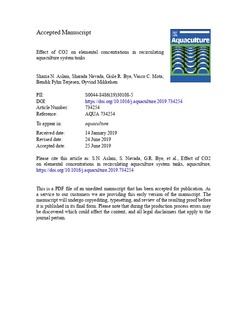| dc.description.abstract | High levels of carbon dioxide (CO2) and subsequent changes in water quality parameters in recirculating aquaculture systems (RAS) are known to impair fish health, welfare and growth performance. A three-month trial was conducted in RAS tanks for Atlantic salmon (Salmo salar) post-smolt, where the effects of CO2 on various water quality parameters (such as pH, redox potential, conductivity, and toxic elements) in brackish water were investigated. The experimental setup contained 18 fish tanks (V = 0.5 m3) with six CO2 treatments (5, 12, 19, 26, 33 and 40 mg CO2 L−1) in triplicate (46 post-smolts tank−1). Initial fish body weight was 70 ± 0.5 g (± SE), final body weight was 232 ± 11 g, and the average growth rate was 1.39% d−1. Fish were fed continuously (approx. 23 h d−1) over satiation (120–140%) during the experiment. Levels of most of the physico-chemical parameters, except for pH (7.65–6.74 for 5–40 mg CO2 L−1 treatments) and redox potential (181.73–195.67 mV for 5–40 mg CO2 L−1 treatments), did not differ between different CO2 treatments. In total, 56 elements were measured, and 32 of these (such as Mg, S, Ca, Cd, Cu, Fe, Pb) were found to be above the limits of detection. None of the elements (except Fe) demonstrated any significant association with CO2 or any of the physico-chemical variables in the current set-up. Fe concentrations were higher in high CO2 treatments (13.0–13.6 μg L−1 for 33–40 mg CO2 L−1) compared with the lower ones (8.7–10.1 μg L−1 for 5–12 mg CO2 L−1), probably due to the differences in pH. Concentrations of dissolved Fe increased over the course of the study, possibly due to the reduced water exchange towards the end of the experiment. Overall, high CO2 levels did not have any significant impact on the physico-chemical properties of water under the conditions of this study. The water exchange rate (39% of system water vol. d−1) and unit processes appeared to produce good water quality because all elements measured herein were within safe recommended limits for salmonids. | |
